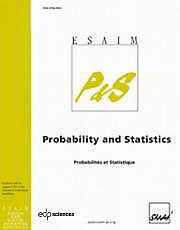Article contents
A Lower Bound on the Growth Exponent for Loop-Erased Random Walk in Two Dimensions
Published online by Cambridge University Press: 15 August 2002
Abstract
The growth exponent α for loop-erased or Laplacian random walk on the integer lattice is defined by saying that the expected time to reach the sphere of radius n is of order nα. We prove that in two dimensions, the growth exponent is strictly greater than one. The proof uses a known estimate on the third moment of the escape probability and an improvement on the discrete Beurling projection theorem.
- Type
- Research Article
- Information
- Copyright
- © EDP Sciences, SMAI, 1999
References
- 5
- Cited by




